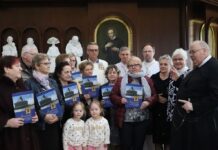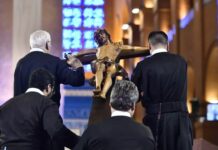“Are our ministries, our works and our presence consonant with what the Spirit asked of our founders and foundresses? Are they suitable for carrying out today, in society and the Church, those same ministries and works? Do we have the same passion for our people, are we close to them to the point of sharing in their joys and sorrows, thus truly understanding their needs and helping to respond to them?” (Letter of Pope Francis to all Consecrated People on the occasion of the Year of Consecrated Life, 2014).
These are the words of Pope Francis today. They are still questions that, in one way or another, the Church has always asked herself when she has sensed that she does not respond adequately to what the men and women of each moment need when the structures of a given moment no longer allow us to fulfill our mission.
That is why the Church has been from its origins in a state of permanent restructuring, has understood that the incarnation is inherent in its essence and its mission. That is why at some point in history, the expression “Ecclesia semper reformanda est” (“The Church must always be in the process of reform”) has been coined. It is about the constant need and the permanent desire of the Church to remain faithful to the Gospel and to the mission received from the Redeemer, in order to better respond to the challenges of each time and each concrete place.
Throughout history, the Holy Spirit has raised up charisms in the Church to help her respond to concrete pastoral urgencies, inspiring reformers such as St. Benedict, St. John of Avila, St. Teresa of Jesus, St. Francis of Assisi, St. Ignatius of Loyola, St. Alphonsus, St. Clement, etc.; they knew how to respond to the needs of their time so that, without losing sight of the essential, they knew how to rebuild in order to generate life, always in fidelity to the Redeemer and the Church. It is the same principle of aggiornamento introduced by John XXIII during the dawn of the Second Vatican Council.
The foundation of the Congregation of the Most Holy Redeemer is the fruit of this generosity of the Holy Spirit, who offered his Church a new missionary charism, this time in the South of Italy at the beginning of the 18th century, by the hand of St. Alphonsus Maria de Liguori. A charism that is recreated in San Clemente when it crosses the Alps and forces the proclamation of the Gospel to be done in a new way. Why in a new way? Because there was a new reality that required “adapting the means to the situations of concrete persons, in the circumstances and according to their possibilities of understanding Christian truth” (Hajduk, Spicilegium 2020, I, p. 108). All this sounds very familiar to us when we use the term “restructuring” today.
We can hardly imagine the turbulence of the period in which St. Clement lived, a period strongly marked by Enlightenment, Josephinism, and the modern society of the eighteenth and nineteenth centuries. These were the years of Napoleon’s domination of Europe, years that were marked by a particular hatred for the Church. This is the context in which St. Clement carried out his mission. This context was almost always hostile: “When everything seemed to be flourishing in St. Benno’s in Warsaw, Napoleonic troops were dispersing the group of Redemptorists that he had formed. When he thought he had found a refuge in peaceful Switzerland, it was the clergy and the cantonal government who were putting up difficulties. When a promising group of young people began to form around him in the imperial capital, Vienna, the police gave him the choice of expatriation or leaving the Congregation. When, once these difficulties were overcome, the emperor was about to sign the approval of the institute, it was a death that took away the comfort of seeing his mission materially fulfilled”. (F. Ferrero, For a historical interpretation of St. Clement, 229)
It was only after his death that the fruits of his mission could be seen. And these fruits would never have been harvested if he had not assumed the reality of his time and made the corresponding adaptations (restructuring). After returning from Rome after his ordination, he could not simply move the structures and methods he had known there. Circumstances forced him to let himself be guided where the Spirit wanted to take him and to use the missionary methods that best responded to the needs of the faithful. And that is precisely what he did.
Sign and seed of renewal in his time
In a time of great change like ours, Christians may be tempted to cling to the past, to “what has always been done.” St. Clement shows us that renewal is possible from within: from the heart, from the community, from the Church, and from the world. What is really exciting about St. Clement “is to see him emerge from a world of the past (hermit, early Redemptorists, Austrian church) to become incarnate, little by little and in all simplicity, in the new world of the Enlightenment, of the revolutions, of the Romanticism and the Restoration, until he occupies one of the first places in the Christian renewal of Central Europe” (F. Ferrero).
It is true that the task is not easy, and that this process of renewal of the Congregation and the Church takes time. St. Clement teaches us that, in the face of the ups and downs of his time, it is all a question of setting out and arming oneself with patience: “Courage! God directs everything,” he used to say (R. Decot), while reorganizing and putting all the resources, creatively, at the service of the mission. St. Clement, far from being a thaumaturgical saint or one with exceptional gifts, was a man exposed to the crises of his time, who did not stop sowing the seed, even when faced with the uncertainty of seeing its fruits. It is interesting to contemplate how the arduous apostolate in Warsaw and Vienna took a turn and bore fruit that he himself had not contemplated. In the face of uncertainty and novelty, together with faith and love for the Church, Clement’s attitude of accepting the risk of failure and error when it comes to opening paths stands out. In this way, like the mustard seed (Mt 13:31), he was a sign and a germ of renewal in his time.
Yesterday and today: two eras, the same constant
With Pope Francis, the Church has embarked on a process of conversion not only “from within” but also by understanding itself as an outgoing Church. In his desire for the renewal of the Church, he has denounced those who resist a change in structures and excuse themselves by saying, “it has always been done this way.”
In the same way, the Congregation embarked on this process of restructuring, which implies a change of structures and missionary availability, finds certain resistance to moving on to a decided missionary ministry. This is why at this time, it is good to refer to Constitution 13, which speaks to us of missionary dynamism: “In carrying out its mission, the Congregation seeks to act with daring initiatives and with tense dynamism. Called to carry out faithfully through the ages the missionary work God has entrusted to it, it is evolving in the way it carries out its mission”.
Constitution 90 states that “Redemptorists will be more effective missionaries to the extent that they adapt their apostolic activity more and more adequately and unite to it a continuous renewal of themselves: spiritual, scientific and pastoral.”
This was well understood by San Clemente. He teaches us today “the importance of adapting pastoral actions to the concrete context in order to announce to people the joy of life in Christ and his Gospel” (Hajduk, 9
Questions for reflection:
– Restructuring is for us today a synonym for the conversion of minds and hearts. What kind of attachments may or may not be favoring the processes of restructuring and renewal within the Church and the Congregation today?
– Are we open to “God’s surprises” or do we close ourselves off, in fear, to the newness of the Holy Spirit? (Pope Francis, May 2013)
– Are we determined to walk the new paths that God’s surprises present us, or do we entrench ourselves in outdated structures that have lost their capacity to respond? (Pope Francis, May 2013)
Prayer
God of infinite goodness,
you restore all things in Jesus Christ the Redeemer,
and by the grace of the Holy Spirit,
you renew everything according to his image.
Grant that, through the intercession of St. Clement,
we too can read the signs of the times and can respond faithfully
and in an ever-new way, to the call you make to us,
to be collaborators in the work of Redemption.
May the intercession and the Perpetual Help of Mary sustain our Congregation,
in the here and now, especially during this restructuring process.
Amen.
——————————————————————————————————
 ONE BODY is a monthly prayer text proposed by the Center for Redemptorist Spirituality.
ONE BODY is a monthly prayer text proposed by the Center for Redemptorist Spirituality.
This text was written by Pedro Lopez, CSsR
For more information: Fr. Piotr Chyla CSsR (Director of the Center for Spirituality – fr.chyla@gmail.com).
Translated by: Manny Rodriguez CSsR







